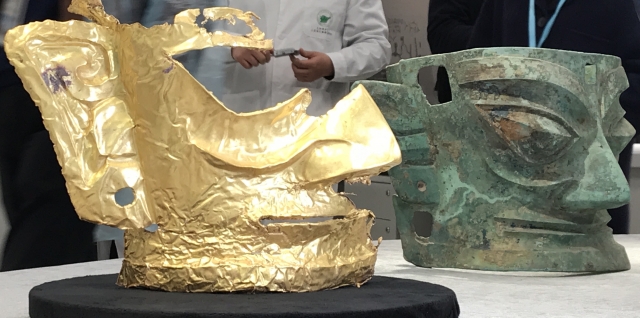The Sanxingdui Ruins site in Sichuan province is generally considered one of most important archaeological sites along the upper reaches of the Yangtze River.
人们普遍认为,四川省三星堆遗址是长江上游最重要的考古遗址之一。
Six pits were newly discovered in the site, according to a news conference in Chengdu on March 20.
据3月20日成都召开的一场新闻发布会通报,三星堆遗址新发现六个“祭祀坑”。
According to Xinhua, these pits date back 3,200 to 4,000 years and include over 500 artifacts.
据新华社消息,这些“祭祀坑”可追溯到3200-4000年前,出土文物500余件。
“Thanks to the new discoveries, we’ve basically figured out the layout of the sacrificial zone of the Sanxingdui site,”
“基于此次新发现,我们已经基本掌握了三星堆遗址祭祀区的布局,”
said Lei Yu, a researcher at the Sichuan Provincial Cultural Relics and Archaeology Research Institute, who heads the ongoing excavation.
四川省文物考古研究院研究员、三星堆遗址考古工作站站长雷雨表示。

The about 12-square-kilometer site was discovered in 1929, and major breakthroughs were made in 1986 with the discovery of two pits believed to be for sacrificial ceremonies.
1929年,这个占地约12平方公里的遗址被发现,1986年考古工作获重大突破,发现两个疑似祭祀仪式场所的坑。
The pits were accidentally uncovered by local farmers digging up earth to make bricks.
这两个坑为当地农民烧砖挖土时意外发现。
Over 1,000 artifacts were found at that time, including elaborately decorated bronzeware, face masks and “divine trees” –
当时,出土文物1000余件,其中包括制作精美的青铜器、面具、
bronze sculptures of trees with their stretching branches.
枝干遒劲的青铜神树。
Lei pointed out that there were many similarities among the recently discovered pits and the two found in 1986, in terms of the types of artifacts unearthed.
雷雨指出,新发现的坑与1986年发现的两个相比,在出土文物种类上存在很多相似之处。
Divine trees and bronze masks were found once again.
神树和青铜面具再次被发现。
The recent discoveries further confirm the theory that the pits were used for sacrificial purposes, as many of the items found had been smashed and burned before being buried.
此次新发现进一步证实了这些坑是用于祭祀的推论,因为发现很多物品在填埋前已被粉碎和焚烧。
Nevertheless, some new types of artifacts have been unearthed.
尽管如此,仍有新种类的文物出土。
For example, in the No 3 pit, archaeologists found two square zun jars, a typical ancient Chinese bronze ritual vessel for holding water or wine, according to Lei.
比如,在3号坑中,考古学家发现了两个方尊,这是典型的中国古代盛水盛酒的青铜礼器,雷雨表示。
Such artifacts were not found in 1986.
1986年没有发现此类文物。
Some of the bronzeware items have been decorated with dragon and ox patterns.
部分青铜器饰有龙、牛图案。
In the No 6 pit, a 1.5-meter-long and 40-centimeter-wide wooden box covered in cinnabar has brought a new mystery. A plan to open it is still being drafted.
在6号坑中,一个1.5米长,0.4米宽,表面有朱砂痕迹的木箱带来新谜团。开箱方案仍在起草。
Other important items include decorative gold items in the shape of birds, ivory and bone carvings, silk and cong –
其他重要文物还包括:鸟形金饰片,象牙及牙雕,丝绸和玉琮。
a jade artifact originating from the 5,000-year-old World Heritage Site Liangzhu Archaeological Ruins in Zhejiang province, about 1,800 kilometers away.
玉琮源自拥有5000年历史的浙江省良渚古城遗址,该遗址拥有被列入世界遗产名录,距三星堆遗址1800公里。
“These artifacts show the Sanxingdui site had a close connection with Central China, but it also marks an original ancient civilization (in Sichuan) with strong creativity,”
“这些文物显示了三星堆遗址与中原文化有着密切联系,也标志着一个极富创造力的(在四川的)原始古老文明,”
said Chen Xiandan, a member of the project who also took part in the 1986 excavation.
参与此次及1986年三星堆考古挖掘的成员陈显丹透露。












